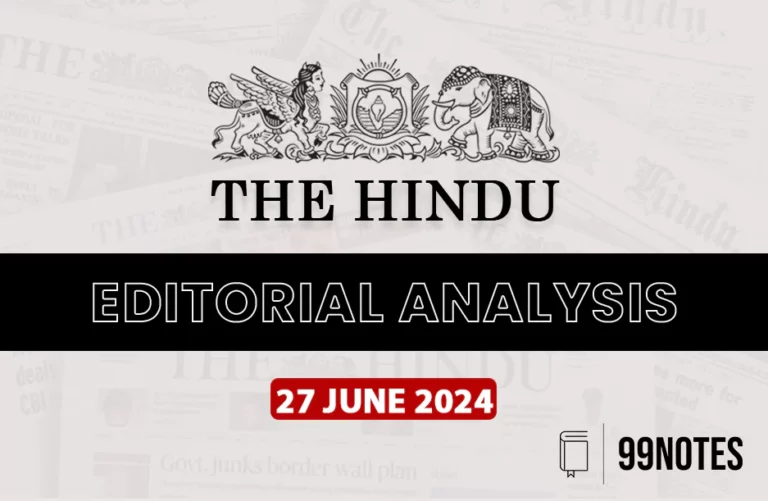3 May 2023 : The Hindu Editorial
The LAC crisis and the danger of losing without fighting.
Topic: GS2 – India and Neighbourhood
Previous year Questions on China:
- With respect to the South China Sea, maritime territorial disputes and rising tension affirm the need for safeguarding maritime security to ensure freedom of navigation and ever flight throughout the region. In this context, discuss the bilateral issues between India and China. (UPSC CSE (M) 2014)
- ‘China is using its economic relations and positive trade surplus as tools to develop potential military power status in Asia’, In the light of this statement, discuss its impact on India as her neighbour. (UPSC CSE (M) 2017)
Context:
- If India does not take proactive measures to address the border crisis, China will continue to have the upper hand and control the timing and location of any actions taken.
- India must take the initiative to regain control of the situation before it becomes too late.
Issue:
- In May 2020, China’s PLA entered multiple areas across the Line of Actual Control (LAC) in Ladakh.
- Some areas have witnessed disengagement three years later, while Depsang and Demchok remain unresolved.
- Diplomatic meetings and talks between corps commanders have yet to progress since September 2020.
- Regular meetings between Indian and Chinese Ministers have not yielded results.
- China has ignored India’s talking points, even after they have been watered down.
The Depsang Crisis of 2013:
- During the 2013 Depsang crisis, the Indian Army launched a quid pro quo operation on the Chinese side in Chumar, forcing the PLA to lift the block on Indian patrols at Bottleneck/Y-Junction and restoring the status quo.
- The criticism of the government at that time was intense, with the PM questioning why soldiers were vacating the area after disengagement if they were on Indian territory.
- However, the PLA has blocked the same spot for over three years, and the media has been silent on the issue despite their earlier strident criticism.
- The political leadership has covered up the situation, possibly to avoid public protest over government incompetence or inaction.
- Lisa Curtis, a former White House official, suggested that the government might not want the public to know the extent of PLA activities in disputed areas.
Incompetence and Iinaction:
- Fear of military escalation drives inaction in response to China’s actions on the disputed border.
- India must militarily take something to negotiate from a position of strength.
- China is a much bigger power overall, but the gap shrinks on the local balance on the LAC.
- The decision to take action rests with the Prime Minister, who seems haunted by the ghost of 1962 and is under pressure to deliver militarily.
- Over nine years, Chinese President Xi Jinping seems to have got the measure of Indian Prime Minister Narendra Modi.
- Mr Modi’s faith in his personality and personal charm to win over the Chinese leader has yet to result in a breakthrough on the Ladakh border.
Way forward – Proactive move:
- India must transfer pressure to China to be proactive in the border dispute.
- India failed to impose its will on China due to fear of military escalation and the ghost of 1962.
- A status quo approach can no longer be the answer, and India must take the initiative to avoid Beijing’s choice of time and place.
India’s High-tech tariffs.
Topic: GS 2 – International Trade (an important hidden topic); GS 3 – Indian Economy
Previous year Questions on WTO/Trade in GS 2:
- “The broader aims and objectives of WTO are to manage and promote international trade in the era of globalization. But the Doha round of negotiations seem doomed due to differences between the developed and the developing countries.” Discuss in the Indian perspective. (2016)
- What are the key areas of reform if the WTO has to survive in the present context of ‘Trade War’, especially keeping in mind the interest of India? (2018)
Context:
- EU may use the WTO ruling as a bargaining chip in free trade agreement negotiations with India.
- WTO ruling may impact negotiations between EU and India on a free trade agreement
Issue:
- The EU, Japan, and Taiwan have filed complaints against India’s tariffs on certain ICT products.
- Three WTO dispute settlement panels have found India violating Article II of GATT.
- India’s tariffs breach its Goods Schedule, which outlines maximum tariff rates committed by WTO member countries.
- The Goods Schedule is based on the HSN, which catalogues traded products with specific names and numbers.
- The HSN system is regularly updated to reflect new products.
The reasoning for higher tariffs:
- India’s tariffs on certain ICT products have been inconsistent with its WTO obligations by three WTO dispute settlement panels.
- India argued that its binding tariff commitments on ICT products are contained in the WTO Ministerial Declaration on Trade in Information Technology Products (ITA Agreement).
- However, the panels held that India’s Goods Schedule, not the ITA, is the source of India’s legal obligations on tariffs, including on products covered by the ITA.
- The panels rejected India’s contention that its commitments under the ITA are “static”.
- The panels also denied India’s argument based on Article 48 of the Vienna Convention on the Law of Treaties.
- India had assumed that its ITA undertakings restricted the scope of its Goods Schedule. Still, the panels held that India failed to show that this assumption was necessary for India’s consent for the Goods Schedule.
Dilution of labour laws by state assemblies
Topic: GS2, GS3. – Labour laws, labour welfare.
Context:
- There are indications that the well-being and rights of India’s workers are being ignored in favour of creating a favourable investment climate to compete with China.
- Legislation passed in Tamil Nadu and Karnataka to extend working hours from 8 to 12 daily.
- Tamil Nadu Chief Minister announced the withdrawal of the legislation during the May Day celebrations.
Issue:
- Legislative changes in Tamil Nadu have led to anger and outcry among trade unions and labour support groups.
- These changes signal governments’ intent to house investments by transnational corporations by ramping up capacities and providing incentives.
- The changes trace their legacy to the four labour codes passed by the central government in 2019-20, which have weakened the labour protection architecture, lowered thresholds, and squeezed collective bargaining.
- The missing component in all these changes is social dialogue, as sustained processes of consultations with workers should be addressed.
- The top-down approach of governance priorities a favourable investment climate over the well-being of workers.





